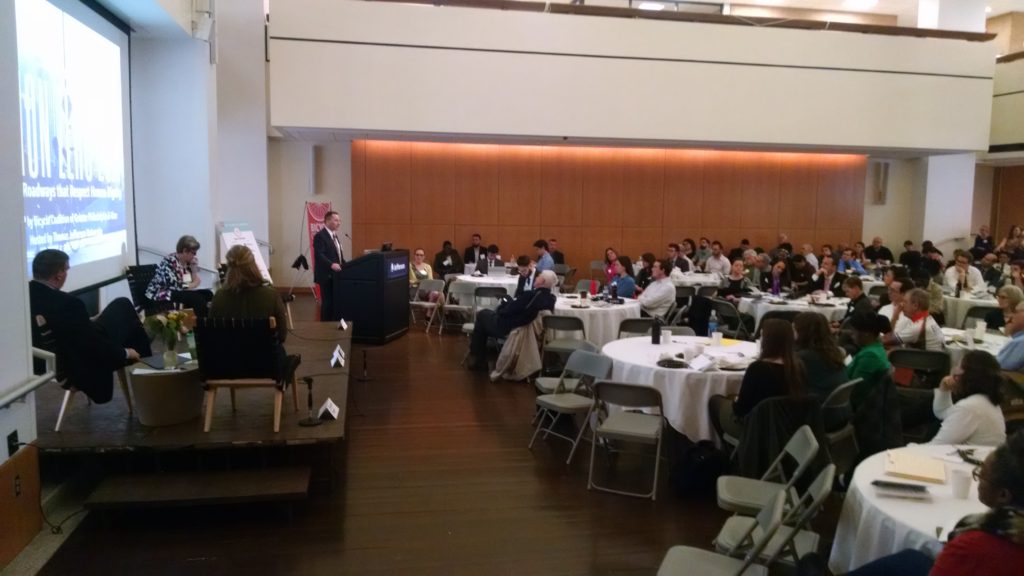
Editor’s note: The Bicycle Coalition of Greater Philadelphia’s Vision zero 2017 Conference was March 1. We will be summarizing the conference’s panels on this blog.
The second panel session of the Vision Zero conference, Safety in Motion: Safety Projects Across Philadelphia, dealt with the current and future safety initiative of four key Philadelphia agencies, the Philadelphia Police Department, SEPTA, the School District of Philadelphia, and the City of Philadelphia’s Office of Transportation and Infrastructure Systems (OTiS).
Captain Fran Healy of the Philadelphia Police Department opened up the discussion with a presentation on the current state of the department as well as its safety efforts regarding traffic enforcement on Roosevelt Boulevard. With 15 traffic deaths this year and 14 the year before, changing the driving culture on the boulevard is a priority for the department, which is currently down 285 officers.
The shortage of manpower, as well the difficulty in catching every speeding car, increases the need for more speed enforcement cameras which, according to Healy, have been shown to lead to slower traffic speeds. These cameras are designed to identify and fine drivers going significantly above the speed limit, not to nab cars moving just slightly above it.
The captain also mentioned the department’s employment of 893 school crossing guards who serve the city’s schools in helping kids safely cross the street.

PPD’s Fran Healy
Scott Sauer, Assistant General Manager of System Safety for SEPTA, spoke next regarding the safety efforts across the city’s various public transit, including bus safety, two regional rail station improvements, bicycle accommodations and education campaigns.
Currently, 120 buses have been installed with a new safe turn alert system that makes an announcement to pedestrians whenever the bus turns a corner. 525 new buses with this system installed are expected to be on city streets within the next year a half; all 1400 city buses will have the safe turn system within the next two a half years, according to Sauer. Regarding bus operator training, a new refreshment program began last year with an emphasis on cyclist and pedestrian interactions with SEPTA buses.
Sauer continued the discussion by addressing critical problems with two regional rail stations, the Lawndale station along the Fox Chase Line and the Fern Rock station. SEPTA’s potential solution includes building two pedestrian underpasses beneath both stations as a way to fix the station’s inconvenient pedestrian crossways. Sauer stressed that these underpasses would not look like tunnels, but have wide, high corridors with lots of lighting.
Changes are happening on the trains as well as at the stations; certain subway cars are currently undergoing pilot testing with a new seating arrangement that makes room for those with bikes.
Sauer also touched on SEPTA’s education campaigns, which includes an annual safety awareness day, and monthly safety blitzes at rail stations and bus terminals to educate public transit users.
Bettyann Creighton of the School District of Philadelphia presented after Sauer, discussing the initiatives begun in her role as executive director of the district’s Office of Health, Safety and Physical Education. The office’s 2006 Bicycle Education Enhancement Program (BEEP), a collaboration with the Coalition, brought safety training courses to the city’s schools. A second program event in 2010 installed 249 bike racks at 44 different Philadelphia schools, and has since implemented Safe Routes Philadelphia lessons into 151 schools.
Unfortunately, the office’s efforts to give driver education lessons to high school students has since been defunded.
The program provided students with the required 30 hours of in class work, and paid for the additional six hours of on the road training. Despite this setback, safety initiatives continue via the use of safety patrols, crossing guards, and bus driver recertification.
The final panelist for the session was Jeannette Brugger of the City of Philadelphia’s Office of Transportation and Infrastructure Systems (oTIS), who described oTIS’s five current streets projects that came out of the 2012 Pedestrian and Bicycle Plan. The first, and already completed project, saw a protected bike lane built on Ryan Avenue, making it the first protected bike lane in the city.

Pictured: Jeannette Brugger
Looking forward, oTIS has plans to add another protected bike lane on Chestnut Street, where crashes occur often between 45 and 34th Streets. The project is currently beginning its community and council outreach stage. The third project focuses on safe routes to school, and aims to relaunch its education component in the coming year.

The Route for Change Program tackles the complicated issues regarding Roosevelt Boulevard. The $5 million project, funded by the Transportation Investment Generating Economic Recovery (TIGER) grant program, serves to improve the corridor to make it welcoming for all methods of transportation. Hoping to decrease the high number of crashes that occur on the boulevard, one potential plan creates an express bus system to help move slow traffic along.
The final project presented by oTIS looks to improve intersections on South Broad St, with a focus on intersections at Walnut and Chestnut Streets. Improvements with LED lighting upgrades, as well as a sidewalk level intersection treatment will help make the intersections safer for pedestrians and cyclists to cross, according to Brugger.
To watch the panel, check out our Facebook page.
